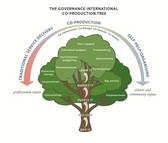Behaviour Change
Behaviour change is often closely associated with co-production of public services, e.g. encouraging people to be more careful in separating their waste into recycling and general waste, so that the local authority can generate cash from the recycled items and save money on landfill. Where potential users can be persuaded to take preventative action, so that they don’t need the services until much later – if at all – this can be seen as co-production of improved outcomes.
Behaviour change was a key theme in the policies of New Labour after 2000, aimed particularly at encouraging people to take preventative action to avoid the kinds of conditions which would require significant public expenditure in the future (Perri 6 et al, 2010). For example. the Flexible New Deal programme encouraged people without jobs to take more seriously their search for jobs. The Sure Start scheme helped parents to take on broader responsibilities for the upbringing of their children Programmes to encourage weight-loss and self-directed health care were particularly high profile examples of behaviour change.
The Liberal-Conservative coalition government has also indicated its interest in behaviour change, particularly linked to the ideas set out in ‘Nudge’ (Thaler and Sunstein) and by Robert Caldini. The idea behind these approaches is that government can subtly incentivise people to change their behaviour through manipulating the ‘choice architecture’ – the Nudge authors refer to their approach as ‘libertarian paternalism’. http://nudges.org/ Examples include having an opt-out scheme for organ donation and pension contributions. The Cabinet Office has set up a ‘nudge unit’, headed by David Halpern from the Institute for Government.
Advocates of co-production often see it as a way to encourage behaviour change. For example in the Prime Minister’s Strategy Unit report, co-production is seen as a way to encourage more responsible behaviour such as better parenting (Horne and Shirley, 2009). The Governance International Close To case study from Austria shows how former driving offenders were able to change the behaviour of young learning drivers to appreciate dangers surrounding driving.The work of RED on encouraging people with diabetes to manage their diets has been described as a form of co-design (Burns et al, 2006). The dialogue between citizens and professionals which takes place through co-production has been seen as a way to make both sides more realistic in their expectations and more willing to trust each other (Bovaird, 2007, p.856).
However, the nudge idea that people can be subconsciously directed by government to make certain choices, does not fit easily with the co-production idea of people actively shaping their lives and communities. Stoker and others have argued that policy makers should deploy nudge approaches alongside ‘think’ approaches, in which people actively deliberate about choices, which may link more naturally to co-production (John et al, 2009).
Here are a two interesting examples of how the behaviour of individuals can be altered.
Publications
6, P., Fletcher-Morgan, C. and Leyland, K. (2010) ‘Making People More Responsible: The Blair Governments' Programme for Changing Citizens' Behaviour’, Political Studies, 58, 3, pp. 427-449.
Bovaird, T. (2007), 'Beyond engagement and participation - user and community co-production of public services', Public Administration Review, 67(5): 846-860.
Horne, M. and Shirley T. (2009), Co-production in Public Services: a new partnership with citizens
John, P., Smith, G. and Stoker, G. (2009) ‘Nudge, Nudge, Think, Think: Two Strategies for Changing Civic Behaviour’, Political Quarterly, 80, 3, pp. 361-70.
Thaler, R. and Sunstein, C. (2008) Nudge: Decisions about health, wealth, and happiness, Yale: Yale University Press.

